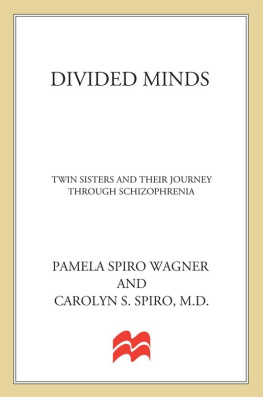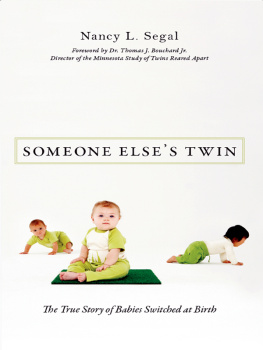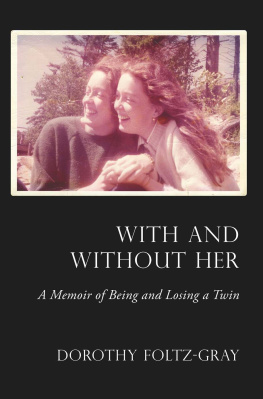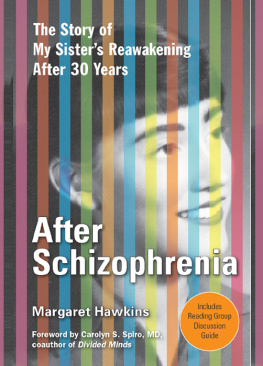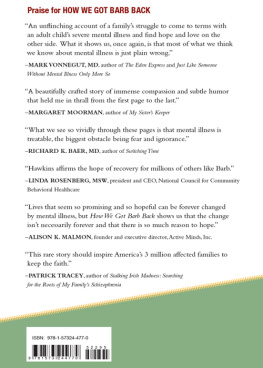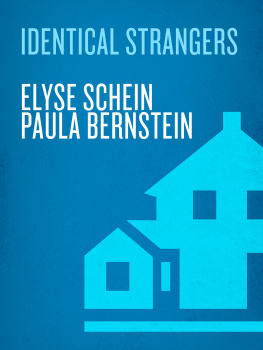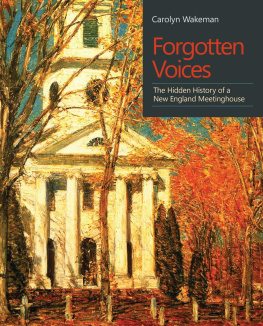There have been numerous people who have helped us in our writing, but in particular wed like to thank E. Fuller Torrey, M.D., without whose helpful advice, this book, written in two voices, would not have been attempted. In addition, Sue Horton, who was at the LA Weekly , was the first person to encourage us to write in the memoir form.
These people, directly and indirectly, contributed: Joe and Lynda Balocca, Phil Becker, Roger Boshes, Ellen Brotherton, Maria Byron, Brian Chiko, Jan Choiniere, Joe Cornelio, Holly Gibson, Carol Goldberg, Mizzy Hanley, Paula Kirkpatrick, Mel Lewis, Tim Pritchett, Joyce Marcotte, Uncle Cy and Aunt Lynn Levine, Kenneth Liegner, Michael McAndrews, Kathy Megan, Lois Morton, Randy Ozar, Elissa Rosen, Ana Velasquez, and all the nurses at New England Home Care, Leila Raim, Linda Rost, Bob Sandine, Barbara Sax, Chickie Smith, George Vaillant, Dan Weisburd, Bill Williams, Penny Wolfson, all the staff at the hospitals that treated Pam after Y2K who supported us through the worst of times, St. Philip Church, and especially the RCIA, which transformed both of our lives in ways we are only just beginning to learn.
Thanks to Diane Higgins, acquisitions editor at St. Martins Press, and associate editor Nichole Argyres, for ushering our book into the world. Most important of all we wish to thank ElizabethFrost Knappman, our agent/editor par excellence, whose expertise guided this book from start to finish.
Irene Kitzman has been like a sister to Carolyn, and extraordinarily generous with her time, her intellect, and her wisdom. She continues to be an unfailing champion for Pamela and an unflagging inspiration to both of us. We owe gratitude more than we can say.
We also wish to thank Mary B. OMalley for getting Pamela through the many bad times as well as the good, and for knowing that we were capable of writing this book even when we did not.
We both thank Allie and Jeremy, Carolyns children, for putting up with our moods, our feuds, and our panics, and for making it all worthwhile.
OCTOBER 2004
Pamela
As I read Lynnies description of my hospitalizations in the fall of 2003, which ECT has largely erased from my memory, I am by turns horrified and ashamed. I cannot believe Ive caused her so much anguish. It is a terrible thing to be psychotic; it is a horrible, frightening, and debilitating condition, the aftereffects of which can last for years. But I never understood quite so viscerally how difficult it is to be the helpless sister of someone who is psychotic. I cant even imagine how it is for the rest of the family. Ignorant of my effect on othersnursing staff, friendsIve lived inside the nightmarish fragments of a time and country beyond understanding, an everlasting present that has no connection to anything or anyone. Ive been literally in a world of my own. Small, terrifying, and constricted as this world is, its been all I know.
I dont remember the whys and wherefores of my raging and outrageous behavior in September; after ECT, I recall even less. Perhaps this is for the best: I did not behave like the kind of person I am when not in the throes of madness.
But madness it was, as anachronistic and moodily romantic as that term is. What else would you call it? I had no idea what I wasdoing or why. I acted solely upon impulse, delusion, and hallucination. That was my reality.
In catatonia, I abdicate livingnot by choice, its true, but nevertheless I am for that time effectively lifeless. And I come close to relinquishing life altogether in my compulsiongoverned by the command hallucinations of the hazmat manto burn myself alive to atone for imaginary crimes. My sin is in being, and I have to unbe, to burn in hell, literally to give myself over to the flames. I am dangerous, I am Satan, the ogre that ate Manhattan, and if I burn the mark of Cain onto my brow, I care little about scarring. All I want is to protect people from my essential evil, from me; my mere presence could poison them beyond remedy. Even in my most evil moments, moments when I feel that I need to destroy myself to save the world, I am still trying to preserve others.
Carolyn
I can never really know the hell in which Pammy lives. When I hang up the phone, hell disappears. But she knows nothing else. Hell is her life. When I look back over the past decades, I weep for her.
I weep for our mother and father, too. In the 1970s, psychiatry had few tools with which to treat schizophrenia and the diagnosis was feared perhaps more than cancer. The common misunderstanding then was that parents were somehow to blame for their childs schizophreniathat something they did or failed to do was the cause. Now, it is understood that this is not so. But, even today, a diagnosis of schizophrenia brings horror, stigma, and denial. No parents should be blamed as our parents were, at least implicitly, for such a devastating disease. By operating as though unproven (and eventually disproved) psychodynamic theories were fact, my profession caused untold pain to our family and surely many other families already torn apart by an illness no one really understands.
Today, though supportive from a distance, our parents, siblings, and extended family are uneasy around Pammy. They fear that awrong look or word will undo her fragile hold on reality. With good reason. At one time or another, each one of us has been the subject of her psychotic tempest. Dad, at first mistaking Pams psychosis for willfulness, chose to withdraw rather than risk his feelings. But I believe that he never stopped loving Pammy, his firstborn. When he would say shes dead to me, there were tears in his eyes. The earliest decade of her illness for him was a head-on collision with disappointment and shame. Pammy, the embodiment of his dreams, smothered by something he didnt recognize or understand. None of us did. Over the decades, Mom, worn down by years of bridging the gulf between daughter and husband, seemed to acknowledge defeat.
But in recent years, she joined me, Chip, and Martha when we began to stop accommodating Dads attempt to wipe the pain of Pammys life from his conversation, his life, his memory. We started talking in front of him about Pammy, her symptoms, her hospitalizations, her treatment. In early 2000, Mom went to see her at Newton Hospital, a difficult task made more excruciating, Im sure, by her memories of Pammys early hospital treatment. Soon after, Chipper and Martha and their families also visited the hospital. And, as they rallied to help me support Pammy, Dads faade began to crumble.
Then, one day last spring, he walked back into her life as if he had never left.
Pamela
Thanks largely to Adas long article in the Hartford paper the previous year, Daddy was finally able to take a brave step toward reconciliation. One miraculous day in 2004, during another hospitalization, he came, alone, to visit me for the first time since my college breakdown, accepting me just as I was at the time and just as I am today, without judgment, without rancor, without visible disappointment. I admire that immensely. It has meant the world to me.
Unlike Lynnie , who converted to Catholicism in 2003, I do not have the church to moor me, to harbor me, to keep my head above water during periods of crisis. To me, human history is forever marred by greed, evil, and injustice. If the universe is good or at least blameless, I can only believe that it must run on its own devices. Governed by its own laws, with its own forces that we know little of, it is a universe of paradox and inconsistency. We can but marvel at and accept it, with a Buddhist-like detachment making life bearable.

